B&B Italia Store Munich, C-Print 71x72,5 cm, Edition 150, Photo © Mary May
B&B Italia Store Munich, Modern Print 40x50 cm, Edition 24, Photo © Mary May
About Art Prints
"(...) Anyone who has ever seen an original print of one of his photographs knows that his love of craftsmanship is close to a doctrine. He is concerned with no less than the ‚soul’ of the print. This haptic impression, being able to feel and sense an original, is what makes each of this photographs live, and unique.(...)“ Felicitas Oeltze von Lobenthal (out of the Coffee Table Book „Men“ by Stefan May)
"A Photo With Soul“
"(...) For Stefan May a high quality Baryta print is an important and unique stylistic medium.“No digital camera or printing procedure reaches the elegance – the "blend“ – that a good Baryta can produce from a negative. This photographer is by no means a dogmatic analogue and Baryta advocate: "But, admittedly, if it weren’t for the good old Baryta print, I’d be wondering why I am still in photography. Actually, to me, it’s simply about finding the best technique to transform my ideas into reality“.
Furthermore, he does not cancel out digital imaging. He applies its potential where it makes sense: „Baryta prints are often the best starting point for further digital imaging. The soul of the photograph lives on ... (...)“ LFI - Leica Fotografie International
Vintage Prints
I. Printtypes
Vintage Print
By common definition a so called Vintage Print is an original print made by the photographer himself or by an authorized lab under the supervision of the photographer – especially black and white images, made on Silver Gelatin Paper (Baryta). Vintage Prints are the first prints (beside Artist Prints) after the photograph was taken. Vintage Prints are mostly signed and stamped by the photographer himself and limited to a very small number (1-5 pieces) – that’s what makes Vintage Prints very rare and valuable.
Artist Prints
Artist Print
Artist Prints are original prints made by the photographer himself or by an authorized lab under the supervision of the photographer. They are the very first prints (beside Vintage Prints) after the photograph was taken. The artist print is functioning as a master print and final test for the photographer before he continues to do his Vintage Prints on Silver Gelatin Paper. The material of an artist print is mostly PE (= polyethylene), but also Silver Gelatin (before 70s) or other various papers when it’s coming to colour images. Artist Prints have notes and signs on the back of the print, are signed or have little abbreviations by the photographer; they are rarely stamped and limited to 1 or 2 pieces. In most cases they are only sold when all other prints are sold out, they can strongly rise in value.
Modern Prints
Modern Print
Modern Prints – also called Late Prints – are printed as a second edition, years after the shooting and after the Vintage Prints were done – you can call them original print as well. They are made by the photographer himself or by an authorized lab under the supervision of the photographer. They can be printed on Silver Gelatin Paper or on different material and in different sizes. Modern Prints are signed and stamped by the photographer and they are limited to a small number (6 up to 100 pieces) – they’re not as expensive as Vintage Prints.
C-Prints
C-Print
Color images where tradionally made as C-Prints (chromogen), since the 50’s it’s a standard method to enlarge color images. Since the mid 70’s Ilfochrome Paper (syn. Cibachrome) was used, a very long lasting paper, which has a special sharpness and gives the image through the metallic effect a more dimensional look. Most photographers nowadays take advantage out of new technologies and use lambda or light-jet printer (laser technology) to enlarge their color images on a varity of modern papers. Those C-Prints are suited perfectly for any individual size up to 180x300cm / 70x117inch. Sometimes large format prints can have a higher price and value than a small size Vintage Print.
Reprints
Reprint
Reprints are subsequent editions; they’re not done under the direct supervision of the photographer and mostly posthuman. They can be printed in different sizes and on different material, the number of limitation can be around 500 copies. The prices for Reprints are quite modest compared to Vintage or Modern Prints of the same size.
Artist Proof
Artist Proof
Artist Proofs are made from digital files of an original Vintage-/Modern- or Master-Print by an authorized lab or print office. The original proofs can be out of a book-/calendar- or other production, often printed on the original paper of the later publication. Mostly they bear notes like „okay“ and signs on the front side, they are marked by little abbreviations of the photographer. These Artist Proofs are extremely rare, mostly only two copies are existing, one for the publisher, one for the Artist.
Papers
II. Paper
Silver Gelatin Paper (Baryta)
Most of Stefan May’s black & white images are printed on Silver Gelatin Paper directly from the original negative. One can still call it a „classical“ material in gallery quality and it lasts for decades.
PE Paper
Since the 70s, PE (polyethylene) prints especially for B/W prints are on the market, they have a different surface and base than the Silver Gelatin Prints, the results are different from Silver Gelatin Prints. Artist Prints are mostly done on PE Paper as a final test for the photographer before doing a Silver Gelatin Print.
Color-/Large Format Paper
Different printing methods for C-Prints, like Lambda,Ligth –Jet or Ink-Jet printer, and a lot of different papers can be used. Large format prints have to be laminated on so called Alu- or Dibond, which is a panel made out of aluminium, a light but strong material for best hold without buckles – even after years. Some people prefer DiaSec, a glass which is mounted directly on the image without using any frame, as a finish for their C-Prints.
Analogue-Cameras
About Technique
"The photographer himself is the only one who can know precisely what he wants to print. Photographers who do not enlarge their own negatives relinquish a very important step in a process that enormously influence the effect of their pictures.“ Andreas Feininger
"(...) It is the art of Stefan May to employ technique as would a director: Sensitive lighting methods and an almost oldfashioned but charming tendency towards traditional quality in black and white are two of his special traits. In the digital world of image processing ... he experiments and explores continually, but he does not turn aside from analogue photography. (...)“ Felicitas Oeltze von Lobenthal (out of the Coffee Table Book „Men“ by Stefan May)
"(...) The motion blur effect characterizing many of his pictures looks as if it were the result of digital manipulation. However all effects are captured in the moment of exposure. (...)“ LFI - Leica Fotografie International
Stefan May works with analogue Hasselblad (6x6 + 4,5x6) and Leica (M + R) cameras, furthermore with a special build "black" Alpa 12 SWA 6x8 view finder camera.
For black & white images he mainly uses Kodak Tri-X films, for colour images Kodak Portra.
"Every photograph is a synthesis of art and technique ... technique alone, without art, is nothing.“ Andreas Feininger









